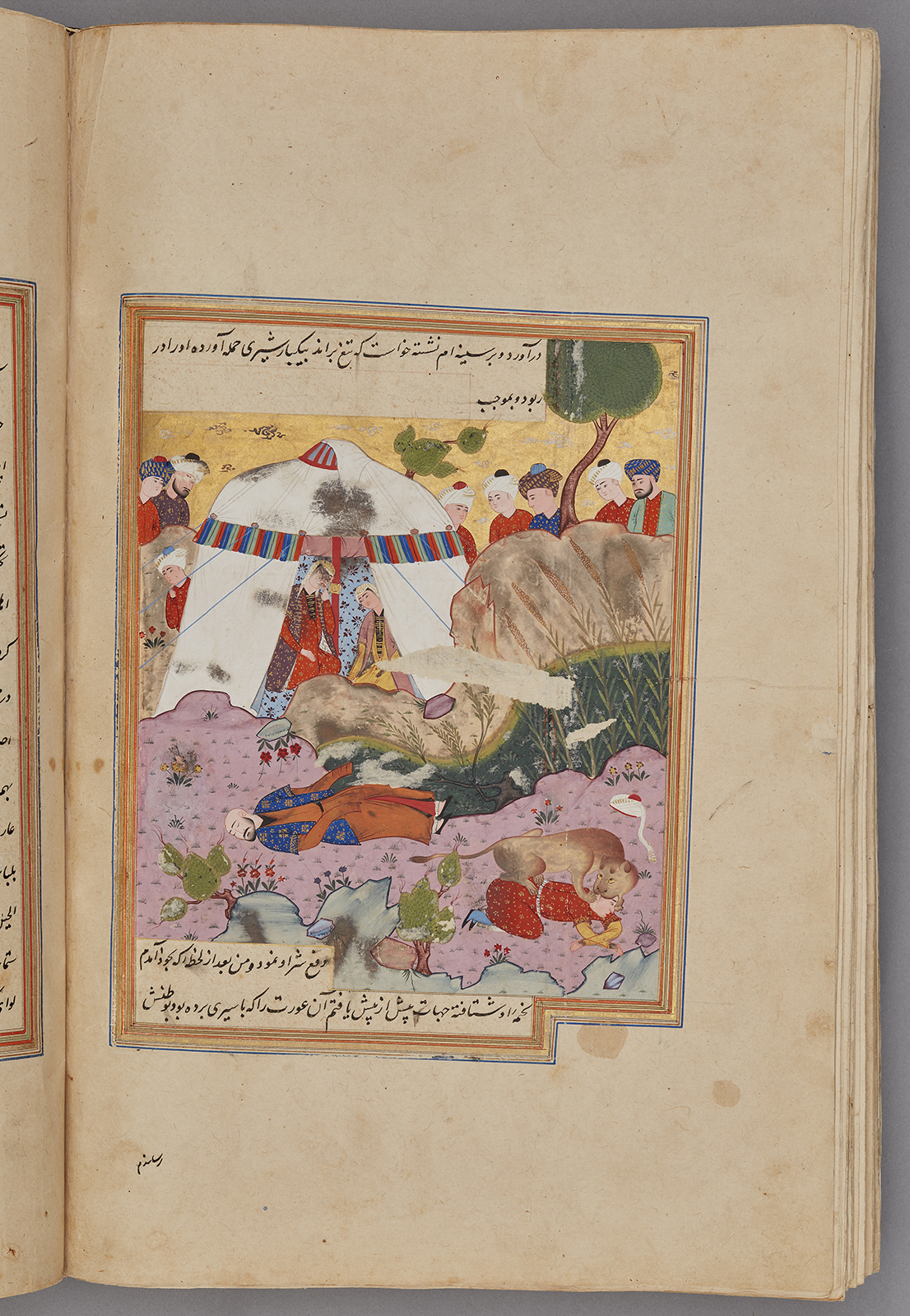Click on the image to zoom
A lion attacking the robber and rescuing a traveler, Folio from a manuscript of Nigaristan
- Accession Number:AKM272.f150v
- Creator:Author: Ahmad b. Muhammad Ghaffari, Persian, died 1567 Scribe: Ahmad al-Shirazi
- Place:Iran, Shiraz (probably)
- Dimensions:38.7 cm × 25 cm × 6.4 cm
- Date:1573-74 CE/980 AH/AH 980
- Materials and Technique:Ink, opaque watercolour, and gold on paper
The miniature painting "A lion attacking the robber and rescuing a traveler" is from an intact manuscript of Kitab-i Nigaristan, a collection of anecdotes and historical incidents written in prose by the historian and scholar Ahmad Muhammad Ghaffari (1504–1567/68) of Kashan in 1551–2. This illustrated manuscript, dated 1573, was probably produced in a Shiraz workshop.
See AKM272 for more information about the manuscript and links to the other illustrations.
Further Reading
Here, a huge white tent is depicted within a landscape on the left side of the illustration. A rock divides the scene horizontally into two parts. In the front half, two men lie on the ground, one of them on the edge of a pond at the foot of the rock. He is lying on his back, his face turned to the right, without headgear and with his eyes closed. The other man is attacked by a lion who attempts to bite the man’s neck. This man tries to protect himself from the deadly bite by curling up his body, causing his turban to fall away.
In the upper half of the picture, behind the rock, figures watch what is happening. In the tent are two women. One holds her finger to her lips as a sign of astonishment. The sky is golden, and only a tree and a few shreds of clouds stand out against this golden background. Except for the lower edge, which is stepped, the framing of the miniature is regular.
The text is placed above and below the pictorial frame. It relays an anecdote about a robber who attacks a traveler and leaves him tied up in the desert. When the traveller can finally free himself from his bonds, he sets out on a long journey through the desert. He sees a fire in the distance at night. Upon arriving at the camp, he realizes that it belongs to the robber, who drags the traveler back into the desert to kill him. Before the robber plunges a knife into the traveler’s heart, a lion appears and attacks the robber. In this way, one "robber" saves the traveler from another robber.
The traveler later returns to the robber's camp, frees a prisoner there, and claims all the looted goods. The illustration captures the climax of the story, when the lion attacks the robber.
This illustration reflects classical traditions of Persian miniatures, including landscapes and outdoor scenes. In this tradition, landscapes are often surrounded by rocks and sometimes a part of the landscape is separated from the rest by a pond or a stream. Flowering trees are typically scattered across the landscape. The horizon line is generally high in these paintings, and is coloured in either blue or gold. In "A lion attacking the robber and rescuing a traveler," gold has been used to produce a luxurious manuscript.
- Elika Palenzona-Djalili
Note: This online resource is reviewed and updated on an ongoing basis. We are committed to improving this information and will revise and update knowledge about this object as it becomes available.


